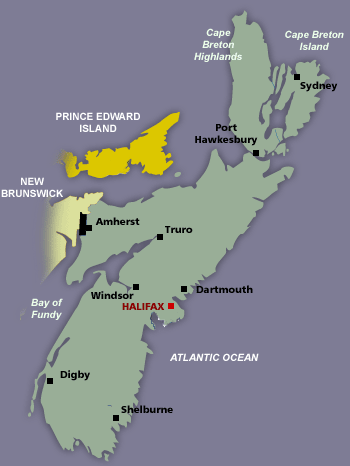Nova Scotia
Pray:
- Pray for the Aglow groups and leaders to be strengthened.
- Pray for all the resources and creativity needed to fulfill the intentions of God in the province of Nova Scotia.
- Pray for the Aglow prayer group in the Capital city.
- Pray for godly government leaders. Blessed is the nation whose God is The Lord, the people whom He has chosen for His own inheritance. Psalm 33:12
Proclaim:
- Arise, shine; for your light has come! And the glory of the LORD is risen upon you. For behold, the darkness shall cover the earth, and deep darkness the people; but the LORD will arise over you, and His glory will be seen upon you. Isaiah 60:1,2 (NKJV)
- Lift up your heads, O you gates! Lift up, you everlasting doors! And the King of glory shall come in. Who is this King of glory? The Lord of hosts, He is he King of glory. Psalm 24:9-10 (NKJV)
Interesting Facts About Nova Scotia
Government: The province of Nova Scotia has a parliamentary form of government. The chief executive of the province is the lieutenant governor, who is appointed by the Canadian governor-general in council to serve a 5-year term. The lieutenant governor, representing the British crown, holds a position that is largely honorary.
The premier, the leader of the majority party, is the actual head of the provincial government and presides over the executive council. The Legislative Assembly contains 52 seats, including those of the premier and the members of the executive council. Members of the legislature are popularly elected to a 5-year term; however, the lieutenant governor, on the advice of the premier, ova Scotia is represented by 10 senators appointed by the Canadian governor-general in council and by 11 members in the House of Commons popularly elected to serve terms of up to five years in the Canadian Parliament.
People: Over 80 percent of Nova Scotia’s population of 940,789 trace their ancestry either wholly or partly to the British Isles. Those with French origin rank second: 18 percent of residents have some French ancestry. The next largest groups by ancestry are German and Dutch.
Many residents of Nova Scotia are also of Polish, Italian, Jewish and Lebanese descent. After the War of 1812, several thousand Blacks, including the Chesapeake Blacks, settled in the Halifax area; today over 15 000 residents of the province have Black origins. More recent immigrants to Nova Scotia have included Chinese, Indo-Chinese, African, Asian and eastern European groups. Almost 22 000 residents of Nova Scotia have Aboriginal origins and primarily belong to the Mi’Kmaq Nation.
The largest concentrations of population are found in the Halifax metropolitan area with a population of approximately 348,000 and the Sydney urban area with approximately 120,000.
History: The Mi’Kmaq Indians inhabited Nova Scotia long before the first explorers arrived from Europe. The first visitors were Norsemen in the early 11th century, and, in 1497, Italian sea captain John Cabot noted the rich fishing grounds in the area. In the 17th century, all of Nova Scotia, as well as parts of Quebec, New Brunswick and Maine were settled by the French. Pierre de Monts established the first successful agricultural settlement in Canada, at Port Royal in 1605. In the next century, the British and the French feuded over the area. Control of the area passed back and forth until 1713, when all of Acadia was ceded to the British under the Treaty of Utrecht.
Worldwide conflict between Britain and France continued. The Acadians, settlers from France, tried to convince both sides of their neutrality, but by 1755 the British had decided that the Acadians posed too great a security threat. They expelled all Acadians who would not swear allegiance to the British Crown. Farms were torched, and the population was expelled. Some escaped, most were deported. Some of the exiles returned to France, some settled in New France. Those deported to the Louisiana Territories in what is today the United States, are now known as “Cajuns.”
In 1783, thousands of colonists loyal to Britain, known as the United Empire Loyalists fled from the newly independent United States. Over 35,000 immigrated to Nova Scotia. The influx of the Loyalists doubled Nova Scotia’s population; and, in 1784, it was partitioned to create the colonies of New Brunswick and Cape Breton Island.
In 1848 Nova Scotia became the first British colony to win responsible government. Nova Scotia was one of the four provinces that constituted the new federation called the Dominion of Canada in 1867, with the signing of the British North America Act. Confederation helped to finance the railroad to Quebec City, which opened the province to the interior of the continent.
The province boomed in the era of the ‘tall ships’ with their wooden hulls and masts. However, international shipbuilding and the lumber and fish trades all faded as the resources depleted and metal ships replaced the great wooden boats of previous eras. The first and second world wars emphasized the importance of Halifax as one of the world’s major military ports. A tragic explosion rocked Halifax when a munitions ship blew up during the First World War.
The twentieth century saw the diversification of Nova Scotia’s economy, and its evolution from a resource-based economy to one that includes many types of production and distribution.
Interesting Facts information from the library.educationworld.net/canadafacts website. Read more about Nova Scotia


